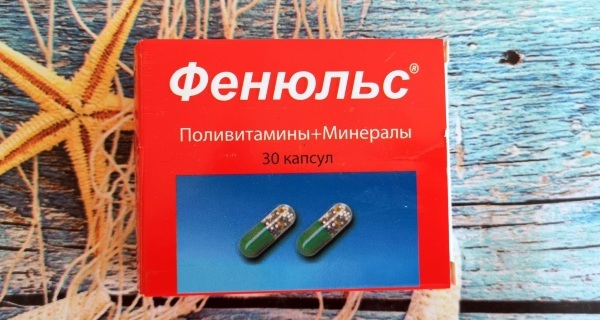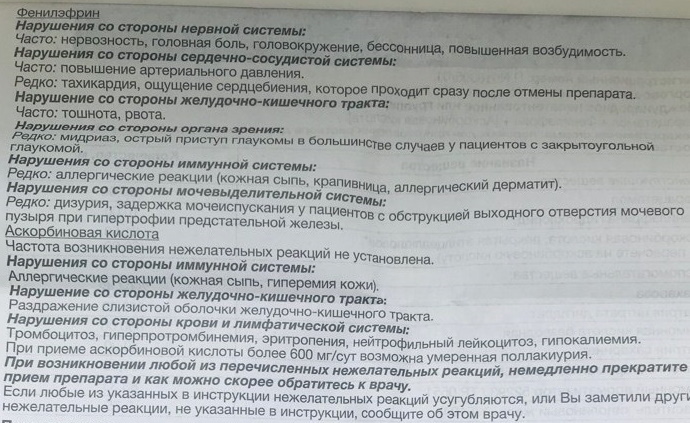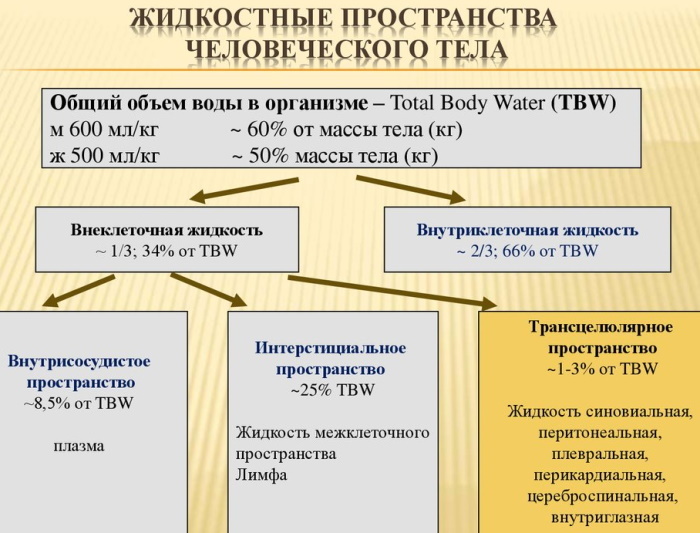Content
- Indications for research
- Preparation for analysis
- Analysis
- For adults
- For kids
- Decoding the results
- Anuria
- Oliguria
- Nocturia
- Polyuria
- Hypostenuria
- Hypersthenuria
- Isostenuria
- Video about urine analysis according to Zimnitsky
Urine according to Zimnitsky - a diagnostic method, allowing you to estimate the rate of formation of urine and its density. The material must be collected correctly, otherwise the doctor may have difficulties with the diagnosis. The technique was developed by S. Zimnitsky in 1925
Indications for research
Urine according to Zimnitsky (it is necessary to collect the correct biomaterial in order to obtain the most reliable result) is one of the research methods. Samples are carried out in order to determine the daily urine output and to identify possible fluctuations in density.
The analysis according to Zimnitsky is prescribed to patients with suspicion of various diseases of the urinary system and kidneys. The sample can be assigned to an adult patient, a child and a pregnant woman.
The main indications for the analysis are:
- renal failure (including severe forms in which the paired organ is unable to excrete or form urine);
- autoimmune diseases of viral etiology (including acute and chronic glomerulonephritis);
- bacterial kidney pathology (including acute pyelonephritis);
- renal cysts;
- pathologies of autoimmune etiology, with the development of which the immune system rejects its own cells (hemorrhagic vasculitis, systemic lupus erythematosus);
- insipidus and diabetes mellitus;
- severe intoxication provoked by poisons, alkalis, salts and acids;
- rheumatoid arthritis, characterized by impaired renal function.
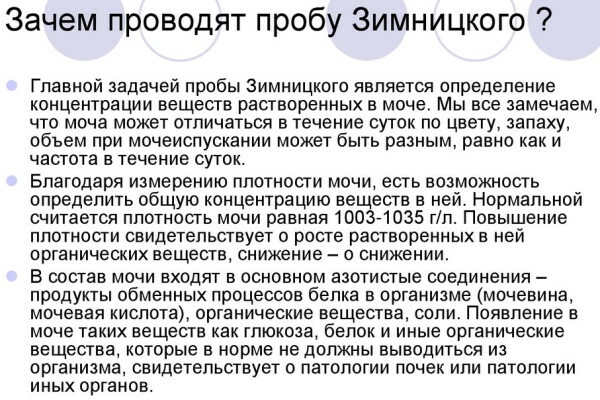
Pregnant women can be prescribed a Zimnitsky test in order to confirm diseases of an infectious nature, characterized by a violation of the functional activity of the urinary tract and reproductive organs systems.
Also, the test allows you to identify the exact cause of the development of edema during pregnancy. The analysis prescribed after delivery helps to confirm or deny pyelonephritis, glomerulonephritis and other pathologies of the paired organ.
Preparation for analysis
On the eve of collecting material for analysis, it is necessary to download it from a specialized website to a smartphone or personal computer. a form diary in which you need to note the amount of liquid consumed during the day (clean water, tea, coffee, freshly squeezed juices, first meal). The volume is measured using a measuring cup.
In 24 hours before the proposed analysis, it is necessary to completely exclude from the diet products that can change the color of the biomaterial (blueberries, carrots, beets). Experts recommend to temporarily stop taking drugs that have a diuretic effect (diuretics, vitamin-mineral complexes).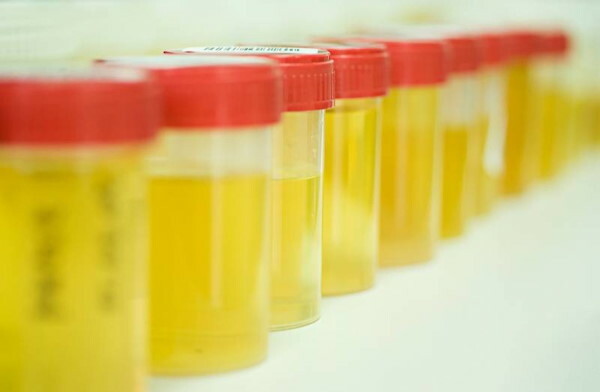
The power mode can be kept as usual (with the exception of the above restrictions). The rate of consumed liquid should not exceed 2.5-3 liters.
Analysis
Urine according to Zimnitsky (you can collect the material correctly if you follow the instructions), as a diagnostic method, allows you to assess the work of the kidneys. The collected material must be taken to the laboratory in the morning.
For adults
On the day of the test, you need to try not to overload the kidneys, therefore, the use of beer and other low-alcohol drinks that have a diuretic effect is strictly prohibited. The biomaterial must be collected within 24 hours. (including night time). In the pharmacy, 8-10 sterile plastic containers with a lid are purchased in advance.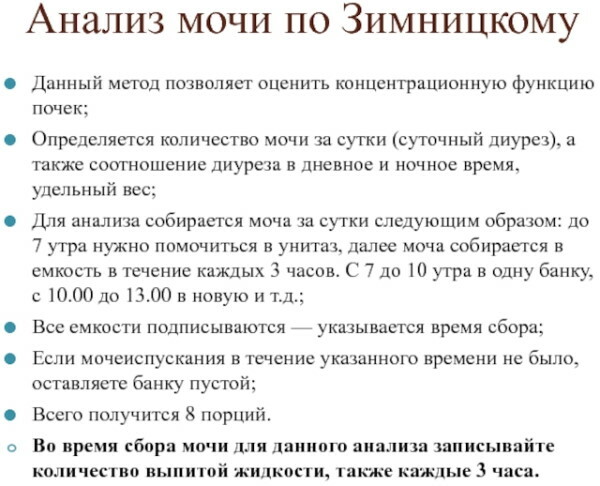
The patient should wake up at 5.00 am. If the patient feels the urge to empty the bladder, then he should pour out the night portion of urine and begin collecting material after 1 hour. (at 6.00). It is important to respect the time intervals.
Adult patients should collect urine in separate containers from 6:00 a.m. of the current day to 6:00 a.m. the next day:
- 1 serving - 6.00-6.30;
- 2 portion - 9.00-9.30;
- Serving 3 - 12.00-12.30;
- Serving 4 - 15.00-15.30;
- 5 portion - 18.00-18.30;
- 6 portion - 21.00-21.30;
- 7 portion - 00.00-00.30;
- 8 portion - 03.00-06.00.
30 minutes. given to the patient to collect biomaterial and label containers. If a person does not feel the urge to urinate at any time period indicated in Zimnitsky's diary, then the container is left empty.
It is impossible to retain urine in the bladder for a long time. If one container is not enough for a portion of urine, then you need to take an additional container, collect the remaining urine from it and indicate the marking "In addition to the portion ...". The analysis includes 8-10 containers (including empty containers). Each plastic jar must be labeled.
The label indicates:
- time period;
- age;
- surname, name, patronymic of the patient.
The container must be sealed and placed on the bottom shelf of the refrigerator. The optimum storage temperature is at least 3 ° C.
For kids
Children under 1 year old are usually not prescribed a Zimnitsky test due to the difficulties that arise when collecting biomaterial. It is not particularly necessary to prepare the child for the upcoming analysis. It is enough to slightly correct his diet, excluding from it any coloring products (beets, blueberries, blueberries, plums).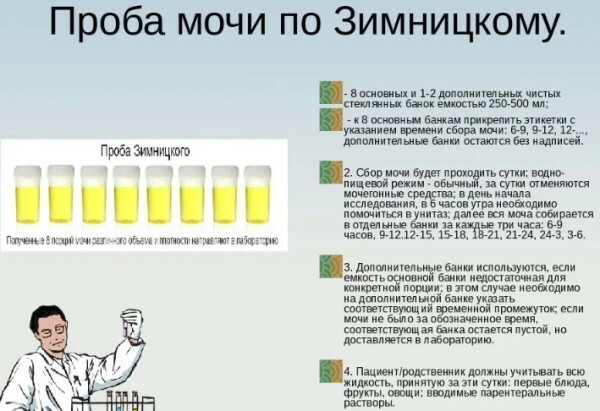
If the child is able to independently announce to the parents about the desire to empty the bladder, then every time the genitals are sanitized. It is enough just to wash them with warm water and soap.
Plastic sterile containers, in the amount of 8-12 pcs. also purchased in advance at the pharmacy. If a child urinates in a pot, then it must be sterilized. It is enough to rinse the pot with boiling water several times. All containers are marked, indicating their age, full name of the child and the time interval.
The collection of urine for analysis according to Zimnitsky begins at 9.00 am. The portions are collected completely. If the urine does not fit into one container, then its remains are poured into the second. If the child does not feel the urge to empty the bladder, then the plastic can should be left empty.
Collection schedule:
- 1 serving - 9.00-9.30;
- 2 portion - 12.00-12.30;
- Serving 3 - 15.00-15.30;
- 4 portions - 18.00-18.30;
- 5 portion - 21.00-21.30;
- 6 portion - 00.00-00.30;
- 7 portion - 03.00-06.00
- 8 portion - 06.00-0.9.00.
For convenience, you can ask your baby to urinate in a sterile glass jar, and then pour the urine into containers from it. It is also necessary to write down the volume of fluid consumed in a diary for a particular time period (tea, juice, milk, jelly, compote, soup).
If the analysis according to Zimnitsky was assigned to the baby, then the collection of biomaterial should be carried out correctly. Under no circumstances should urine be squeezed out of a diaper or diaper. Parents can use special drainage bags (separate for girls and boys). You can buy them at the pharmacy.
Decoding the results
Urine according to Zimnitsky (you need to collect it correctly at a certain time) is an analogue of osmolar analysis. Normally, the daily volume of urine ranges from 1-2 liters. (no more than 80% of the total amount of fluid consumed per day).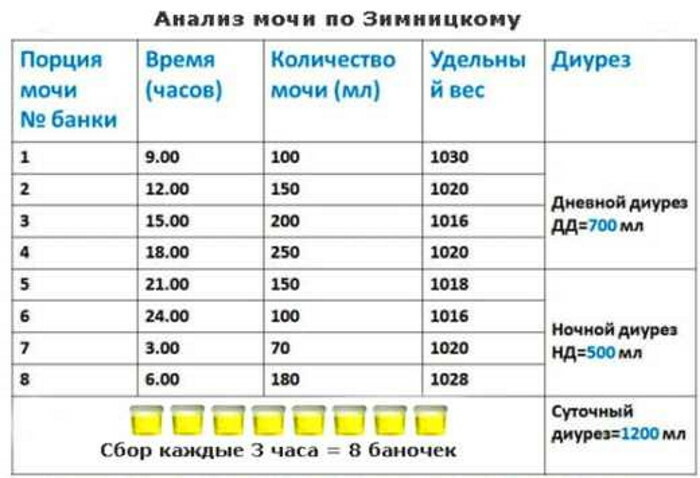
The amount of urine, depending on a particular time period, can fluctuate between 40-300 ml. The specific gravity of urine normally varies in the range of 1.005-1.040 g / l. In a healthy person, nighttime diuresis is less than daytime. In the daytime, more than 2/3 of the total volume is released.
Anuria
With anuria, the volume of urine excreted per day does not exceed 100 ml. This condition is life-threatening. The patient has difficulty emptying the bladder, despite adhering to the drinking regimen. There are several main causes of anuria.
They are conventionally divided into 3 categories:
- postrenal;
- renal;
- prerenal.
Postrenal anuria is characterized by obstruction or blockage of the urinary tract. Obstruction often occurs against the background of compression, strictures, or the formation of calculi. At first, the kidneys work as usual, then against the background of the filtration pressure that has arisen, urine ceases to be supplied to the bladder. With a blockage of the urinary tract, there is a high risk of ischemia, necrosis and edema.
Renal anuria can be triggered by various inflammatory processes and the penetration of allergic toxins into the body. The clinical syndrome can be accompanied by glomerulonephritis and pyelonephritis. A decrease in the volume of daily diuresis is observed in severe intoxication with metals, solvents, alkalis, acids.
Prerenal anuria develops against the background of circulatory disorders inside the kidneys.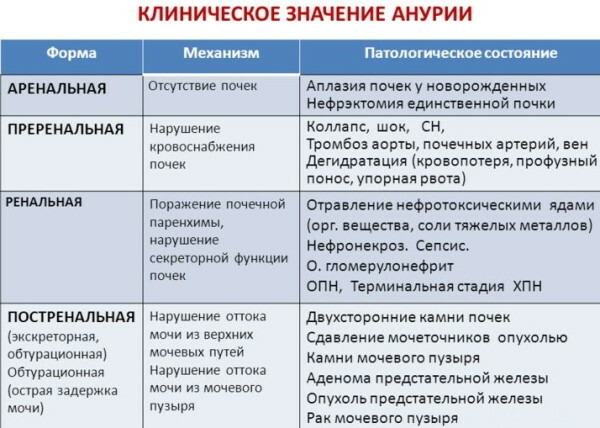
The onset of a clinical syndrome can be triggered by:
- thromboembolism;
- myocardial infarction;
- pancreatitis;
- peritonitis;
- intestinal obstruction;
- internal bleeding;
- hepatorenal syndrome.
The following symptoms may indicate the development of anuria:
- apathy;
- weight loss;
- fast fatiguability;
- vomit;
- diarrhea;
- partial or complete cessation of urination.
In the absence of adequate treatment, anuria can provoke renal failure and uremia, as a result of which the patient's death occurs after 9-10 days from the moment of development.
Oliguria
Urine according to Zimnitsky (you can collect the correct material according to the standard algorithm, which the doctor will explain) is a sample that allows you to diagnose a number of kidney diseases in time. The analysis allows you to timely identify oliguria - a clinical syndrome in which urine output drops to 400 ml. There may be several reasons for the development of a pathological condition.
The prerenal form can be considered common.
A sharp decrease in the volume of daily urine output occurs in the following situations:
- Dehydration. The condition can be triggered by profuse bleeding, burns, diarrhea, and vomiting.
- Pathology of the organs of the cardiovascular system. Oliguria can be considered a sign of pericarditis, heart defects (including congenital forms), cardiomyopathy, heart failure, myocardial infarction.
- Decreased vascular tone. In this case, oliguria indicates the development of traumatic, cardiogenic shock or sepsis.
-
Renal obstruction. The clinical syndrome develops against the background of thrombocytopenic purpura, hemolytic uremic syndrome, microangiopathy, muscular dysplasia and arterial stenosis.
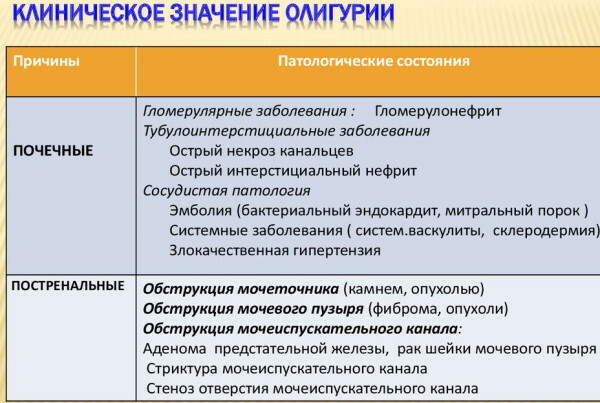
The reasons for the development of renal oliguria are considered:
- intoxication with metal salts;
- long-term use of medications that can have a nephrooxic effect (cytostatics, non-steroidal anti-inflammatory drugs, aminoglycosides);
- rhabdomyolysis;
- vasculitis;
- systemic lupus erythematosus;
- polycystic;
- hydronephrosis;
- acute pyelonephritis;
- chronic and acute glomerulonephritis.
Postrenal oliguria can be caused by colon cancer, aortic aneurysm, lymphoma, and fibrosis.
Nocturia
With nocturia, the volume of nocturnal urine output increases. The patient constantly wakes up (more often 3 times) with an acute desire to empty the bladder. Even during the day, he is forced to interrupt his sleep due to the urge to urinate. Usually, the excess of urine output falls on the time interval from 18.00 to 6.00. The pathological condition can be caused by diseases of the internal organs.
A healthy person should empty the bladder 5-6 times a day. The volume of each portion of urine varies between 150-350 ml.
The main reasons for the development of nocturia are considered:
- long-term use of drugs that can have a diuretic effect (medicines for hypertension, diuretics);
- the growth of malignant and benign neoplasms in the organs of the urinary system;
- stressful situations characterized by anxiety;
- various violations of the biological cycle (including changing places of the modes of wakefulness and sleep);
- prolapse;
- non-compliance with the drinking regime (consumption of more than 3 liters. liquids per day);
- hypercalcemia;
- reduction in the size of the bladder (including surgery, accompanied by excision of its part).
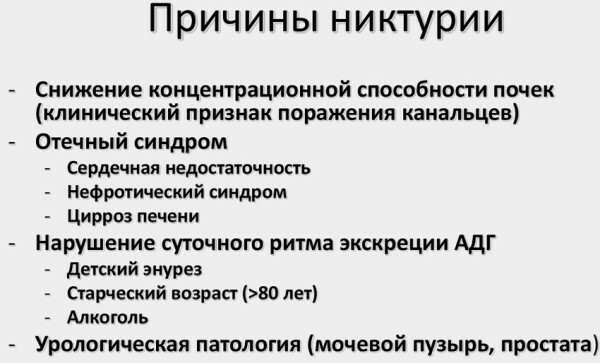
A number of accompanying symptoms can indicate the development of nocturia, therefore, with an increase in the volume of nocturnal diuresis, patients need to pay attention to their own health.
Signs of the clinical syndrome:
- fast fatiguability;
- anxiety;
- swelling;
- enuresis;
- sleep disorders;
- pain in the lumbar region and coccyx.
Nocturia in men can be caused by an adenoma. In patients in this case, there is a change in the color of urine and a decrease in libido.
Polyuria
According to Zimnitsky, urine is a rather informative method of laboratory diagnostics. Correctly collected biomaterial helps to obtain a reliable result. Polyuria is characterized by an increase in the volume of daily urine output by 3 or more times. Unlike pollakiuria, the clinical syndrome is characterized by polydipsia - the patient is very thirsty, drinking 5-6 liters of liquid per day instead of the allowed 3 liters.
Polyuria resulting from the intake of large doses of alcohol usually resolves on its own within 24-48 hours.
The reasons for the development of a pathological syndrome include:
| Causes | Development mechanism |
| Diabetes | With glycemia, glucose, which is osmoactive, does not have time to be broken down in the kidneys. The increase in urine volume occurs against the background of water penetration into the renal tubules. Polyuria in diabetes mellitus correlates with the concentration of glucose in the body. If the level of the substance is reduced, then the dialysis is normalized. |
| Taking some medications | Taking some medications. Polyuria can occur during treatment of certain diseases with osmotic or loop diuretics. Some people try to lose weight by taking these drugs uncontrollably. Antifungal, psychotropic drugs and antibiotics can also provoke an increase in the volume of daily urine. |
| Diabetes insipidus | Vasopressin deficiency can provoke the development of polyuria. The pathological syndrome can be considered a symptom of diabetes insipidus. The disease develops against the background of histiocytosis, sarcoidosis, encephalitis, pituitary or hypothalamic tumors, traumatic brain injury, amyloidosis, hypokalemia and hypercalcemia. |
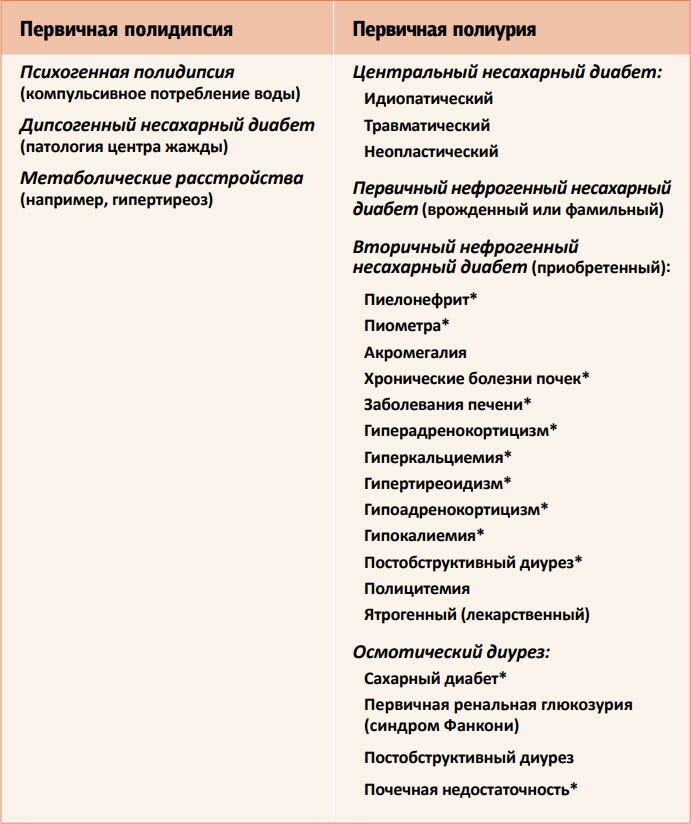 In patients with primary polydipsia, severe polyuria is observed. The urge to drink water uncontrollably is caused by a mental disorder.
In patients with primary polydipsia, severe polyuria is observed. The urge to drink water uncontrollably is caused by a mental disorder.
Hypostenuria
Hypostenuria is characterized by a decrease in urine density (1000 g / l). The clinical syndrome is caused by a violation of the functional activity of the kidneys, provoked by diseases of the nephrological type.
To get rid of hypostenuria, it is necessary to make an accurate diagnosis and identify the cause of the development of the clinical syndrome. Physiological indicators of urine density directly depend on a number of factors. If a person consumes a lot of fluids during the day, then the kidneys lose the ability to quickly concentrate urine.
Hypostenuria can occur with prolonged use of osmotic and loop diuretics. During this period, patients experience severe swelling.
The most common causes of the development of a pathological syndrome include pathologies characterized by a violation of the ionic balance and damage to the renal tubules. The paired organ loses the ability to excrete chlorides, calcium, potassium, sodium and other electrolytes into urine.
Hypotension is observed in the following diseases:
- chronic renal failure;
- nephritis;
- hypertensive nephropathy;
- pyelonephritis;
- glomerulonephritis.
Hypostenuria also occurs with diabetes insipidus. Urine becomes less concentrated with a deficiency of the antidiuretic hormone vasopressin.
The main reasons for the development of NSD are considered:
- hypokalemia;
- hypercalcemia;
- encephalitis;
- meningitis;
- brain cancer.
The accompanying symptoms of hypostenuria include nocturia, severe thirst, and blood pressure surges.
Hypersthenuria
With hypersthenuria, the specific gravity of urine increases (more than 1004 g / l). Most often, the syndrome develops against the background of diabetes and dehydration. Fluctuations in the specific gravity of urine are observed even in healthy people during the daytime. Hypersthenuria of this type is called short-term, it usually goes away on its own.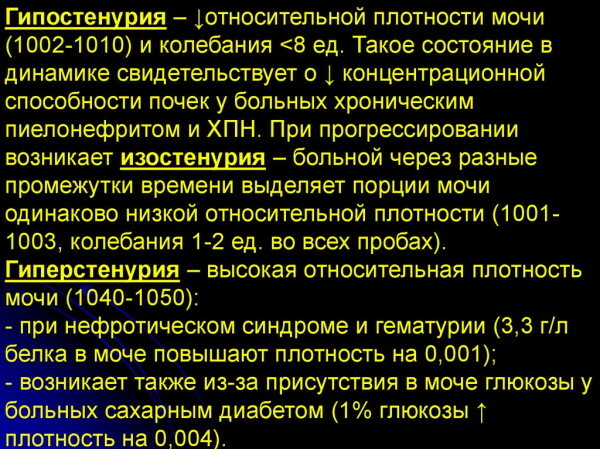
With dehydration (dehydration), the body experiences a lack of fluid, so urine becomes more concentrated against the background of the presence of electrolytes in its composition. If the deficit is filled in time, urine will acquire the necessary density.
Dehydration often develops against the background of the following diseases:
- sepsis;
- malaria;
- enteropathy;
- intestinal infections;
- severe intoxication, characterized by diarrhea and vomiting.
People with diabetes mellitus suffer from hypersthenuria. Glucose can increase urine density by 0.005 c / ml every 4-5 hours. With diabetes mellitus, ketonuria also develops. With an excess of vasopressin, urine becomes more concentrated, and water is absorbed quickly in the renal tubules.
Hypersthenuria also occurs in people with adrenal insufficiency. If the body is unable to produce the required amount of aldosterone, then sodium is rapidly excreted from the body along with urine. The clinical syndrome may indicate the development of heart failure. In this case, the load on the heart increases due to the inability of the ventricles to contract at full force.
Isostenuria
This clinical syndrome is not life-threatening. With monotonous diuresis (isistenuria), urine density may fluctuate slightly within 24 hours.
The clinical syndrome often indicates the development of the following diseases:
- hemorrhagic vasculitis;
- gout;
- rheumatoid arthritis;
- hepatitis C, B;
- diseases of autoimmune etiology, in which the functional activity of the kidneys is impaired;
- arterial hypertension;
- diabetes;
- renal failure;
- nephrosclerosis;
- renal cysts;
- nephritis;
- glomerulonephritis.
Concomitant symptoms indicating the development of isostenuria include:
- frequent urge to urinate;
- rapid fatigue;
- lower back pain;
- spasms in the right hypochondrium;
- spikes in blood pressure.
Isotenuria can occur with a salt-free diet or long-term use of loop diuretics.
Urine according to Zimnitsky is a rather informative analysis. To get the most reliable result, it is important to collect the biomaterial correctly. The cost of a sample according to Zimnitsky in private laboratories varies between 500-750 rubles.
Video about urine analysis according to Zimnitsky
Urine analysis according to Zimnitsky:

